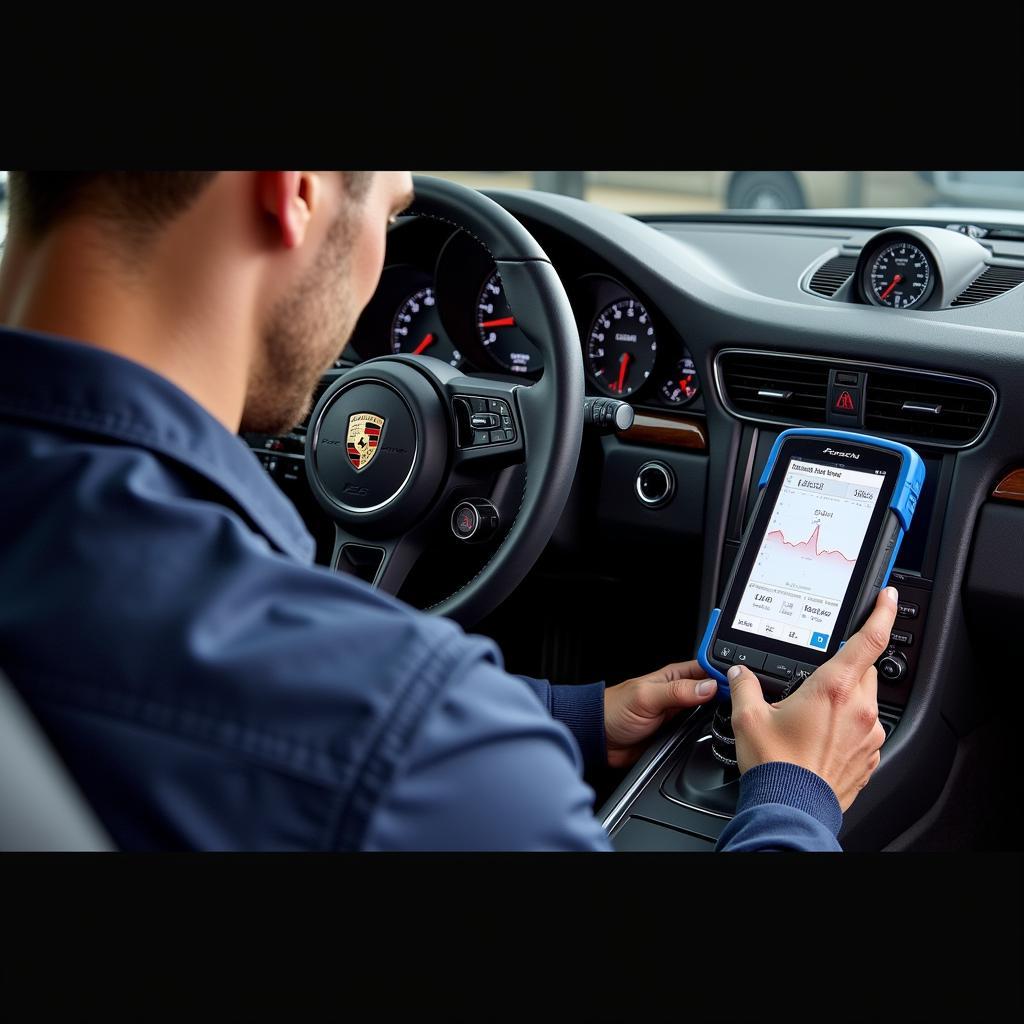Owning a Porsche is a dream come true for many. However, keeping these high-performance machines running smoothly requires specialized care. That’s where Porsche diagnostic equipment comes in, offering advanced tools to identify and address issues quickly and accurately. This comprehensive guide explores everything you need to know about Porsche diagnostic equipment, empowering owners, repair shops, and technicians to make informed decisions about maintaining these automotive masterpieces.
Understanding the Importance of Specialized Diagnostics
Porsche vehicles are renowned for their sophisticated engineering and cutting-edge technology. This complexity extends to their electronic systems, which play a crucial role in everything from engine management and transmission control to driver assistance and infotainment. Consequently, diagnosing and resolving issues in a Porsche requires specialized equipment and expertise.
Unlike generic OBD-II scanners that provide basic fault codes, Porsche diagnostic equipment delves deeper. It communicates directly with the vehicle’s multiple control units, accessing real-time data streams, historical fault logs, and component-specific parameters. This allows for a much more precise and efficient diagnosis, eliminating guesswork and unnecessary repairs.
Exploring the World of Porsche Diagnostic Equipment
There are various types of Porsche diagnostic equipment available, catering to different needs and budgets. Here are some key categories:
1. Factory-Level Diagnostic Tools
Porsche PIWIS 3 software represents the pinnacle of Porsche diagnostic capabilities. This dealer-level software, often referred to as piwis software porsche, offers comprehensive coverage of all Porsche models, including the latest generations. It provides unparalleled access to vehicle systems, enabling functions such as:
- Complete Vehicle Diagnostics: Reading and clearing fault codes across all control units
- Live Data Monitoring: Observing real-time sensor readings and system parameters
- Actuator Tests: Commanding individual components to verify their operation
- Coding and Programming: Updating software versions, configuring control units, and adapting new modules
- Guided Troubleshooting: Providing step-by-step instructions for diagnosing and resolving specific issues
Due to its advanced capabilities and high cost, piwis porsche software is typically found in authorized dealerships and specialized Porsche repair shops.
2. Professional-Grade Scan Tools
For independent repair shops and experienced technicians, professional-grade scan tools offer a balance between functionality and affordability. While not as comprehensive as PIWIS III, these tools can still access a wide range of Porsche-specific data and perform many advanced functions.
Some popular options include:
- Launch X431: Known for its extensive vehicle coverage, user-friendly interface, and powerful diagnostic capabilities
- Autel MaxiSys: Offering a comprehensive suite of features, including coding and programming for various Porsche models
- Foxwell NT530: Providing dedicated Porsche software options for in-depth diagnostics and maintenance functions
3. DIY-Friendly Code Readers
For Porsche owners who prefer to handle basic diagnostics themselves, several DIY-friendly code readers are available. These devices, often more affordable, can read and clear basic fault codes from the engine, transmission, airbags, and other common systems. While they may not offer the depth of professional-level tools, they can be helpful for identifying minor issues or monitoring warning lights.
Choosing the Right Porsche Diagnostic Equipment
Selecting the appropriate Porsche diagnostic equipment depends on several factors, including:
- Budget: Factory-level tools like PIWIS III are expensive, while professional-grade options offer varying price points based on features and coverage.
- Technical Skill: Using advanced diagnostic equipment requires technical knowledge and experience.
- Intended Use: For basic code reading and clearing, DIY-friendly options may suffice. However, for in-depth diagnostics, coding, or programming, professional-grade or factory-level tools are necessary.
The Future of Porsche Diagnostics: Remote Services and Software Updates
With the automotive industry’s rapid advancements in connectivity and software-defined vehicles, the future of Porsche diagnostics looks promising. Remote diagnostics, already emerging, allow technicians to access and analyze vehicle data remotely, enabling faster issue identification and potential solutions without needing a physical inspection.
Over-the-air software updates are becoming increasingly prevalent, allowing manufacturers to remotely deploy software patches and feature upgrades, potentially resolving issues and enhancing vehicle performance without a trip to the dealership.
Conclusion
Investing in the right Porsche diagnostic equipment is crucial for maintaining these exceptional vehicles’ performance, reliability, and safety. Whether you’re a Porsche owner, an independent repair shop, or a seasoned technician, understanding the available options and their capabilities can empower you to make informed decisions about diagnostics and repairs.
For expert advice and assistance in selecting the ideal Porsche diagnostic equipment for your needs, contact CARDIAGTECH today at +1 (641) 206-8880 or CARDIAGTECH[email protected]. Our team of specialists, based in Orange, New Jersey, is dedicated to providing top-notch solutions and support to keep your Porsche running flawlessly.


